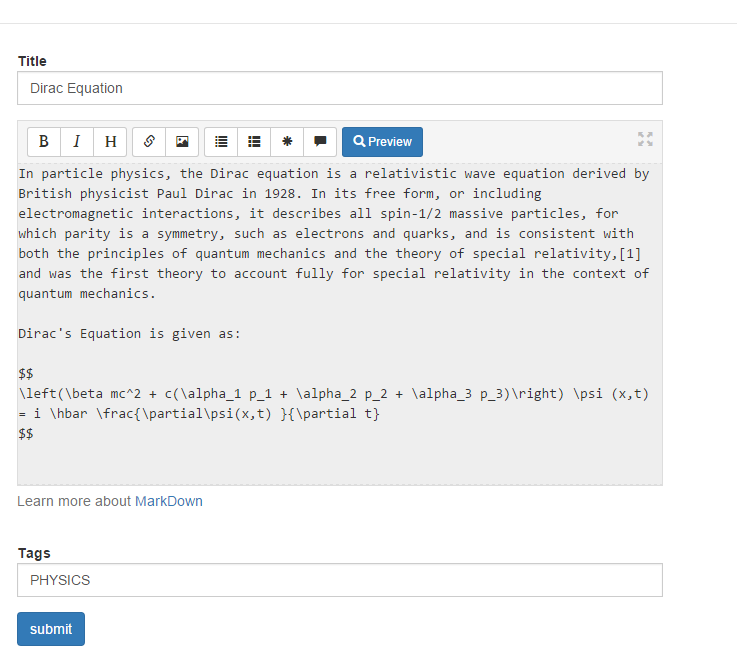Flask-Blogging¶
Flask-Blogging is a Flask extension for adding blog support to your site. It provides a flexible mechanism to store the data in the database of your choice. It is meant to work with the authentication provided by packages such as Flask-Login or Flask-Security.
The philosophy behind this extension is to provide a lean app based on markdown to provide blog support to your existing web application. This is contrary to some other packages such as that are just blogs. If you already have a web app and you need to have a blog to communicate with your user or to promote your site through content based marketing.
Out of the box Flask-Blogging has support for the following:
- Bootstrap based site
- Markdown based blog editor
- Models to store blog
- Authentication of User’s choice
- Sitemap, ATOM support
- Disqus support for comments
- Google analytics for usage tracking
- Well documented, tested, and extensible design
Quick Start Example¶
from flask import Flask, render_template_string, redirect
from sqlalchemy import create_engine
from flask.ext.login import UserMixin, LoginManager, \
login_user, logout_user
from flask.ext.blogging import SQLAStorage, BloggingEngine
app = Flask(__name__)
app.config["SECRET_KEY"] = "secret" # for WTF-forms and login
# extensions
engine = create_engine('sqlite:////tmp/blog.db')
sql_storage = SQLAStorage(engine)
blog_engine = BloggingEngine(app, sql_storage, url_prefix="/blog")
login_manager = LoginManager(app)
# user class for providing authentication
class User(UserMixin):
def __init__(self, user_id):
self.id = user_id
def get_name(self):
return "Paul Dirac" # typically the user's name
@login_manager.user_loader
@blog_engine.user_loader
def load_user(user_id):
return User(user_id)
index_template = """
<!DOCTYPE html>
<html>
<head> </head>
<body>
{% if current_user.is_authenticated() %}
<a href="/logout/">Logout</a>
{% else %}
<a href="/login/">Login</a>
{% endif %}
  <a href="/blog/">Blog</a>
  <a href="/blog/sitemap.xml">Sitemap</a>
  <a href="/blog/feeds/all.atom.xml">ATOM</a>
</body>
</html>
"""
@app.route("/")
def index():
return render_template_string(index_template)
@app.route("/login/")
def login():
user = User("testuser")
login_user(user)
return redirect("/blog")
@app.route("/logout/")
def logout():
logout_user()
return redirect("/")
if __name__ == "__main__":
app.run(debug=True, port=8000, use_reloader=True)
The key components required to get the blog hooked is explained below.
Configuring your Application¶
The BloggingEngine class is the gateway to configure blogging support to your web app. You should create the BloggingEngine instance like this:
blogging_engine = BloggingEngine()
You also need to pick the storage for blog. That can be done as:
from sqlalchemy import create_engine
engine = create_engine("sqlite:////tmp/sqlite.db")
storage = SQLAStorage(engine)
Once you have created the blogging engine and the storage, you can connect with your app using the init_app method as shown below:
blogging_engine.init_app(app, storage)
Flask-Blogging lets the developer pick the authentication that is suitable, and hence requires her to provide a way to load user information. You will need to provide a BloggingEngine.user_loader callback. This callback is used to load the user from the user_id that is stored for each blog post. Just as in Flask-Login, it should take the unicode user_id of a user, and return the corresponding user object. For example:
@blogging_engine.user_loader
def load_user(userid):
return User.get(userid)
For the blog to have a readable display name, the User class must
implement either the get_name method or the __str__ method.
The BloggingEngine accepts an optional config dict argument which is passed to all
the views. The keys that are currently supported include:
| SITENAME | The name of the blog to be used as the brand name (default “Flask-Blogging”) |
| SITEURL | The url of the site. |
| RENDER_TEXT | Boolean value to specify if the raw text should be
rendered or not. (default True) |
| DISQUS_SITENAME | Disqus sitename for comments (default None) |
| GOOGLE_ANALYTICS | Google analytics code for usage tracking
(default None) |
The BloggingEngine accepts an optional extensions argument. This is a list
of Markdown extensions objects to be used during the markdown processing step.
Blog Views¶
There are various views that are exposed through Flask-Blogging. If the url_prefix
argument in the BloggingEngine is /blog, then the URL for the various views are:
/blog/(GET): The index blog posts with the first page of articles./blog/page/<post_id>/<optional slug>/(GET): The blog post corresponding to thepost_idis retrieved./blog/tag/<tag_name>/(GET): The list of blog posts corresponding totag_nameis returned./blog/author/<user_id>/(GET): The list of blog posts written by the authoruser_idis returned./blog/editor/(GET, POST): The blog editor is shown. This view needs authentication./blog/delete/<post_id>/(POST): The blog post given bypost_idis deleted. This view needs authentication./blog/sitemap.xml(GET): The sitemap with a link to all the posts is returned.
The view can be easily customised by the user by overriding with their own templates. The template pages that need to be customized are:
blog/index.html: The blog index page used to serve index of posts, posts by tag, and posts by authorblog/editor.html: The blog editor page.blog/page.html: The page that shows the given article.blog/sitemap.xml: The sitemap for the blog posts.
Useful Tips¶
If you use
psycopg2driver for Postgres while using theSQLAStorageyou would need to haveautocommitturned on while creating the engine:create_engine("postgresql+psycopg2://postgres:@localhost/flask_blogging", isolation_level="AUTOCOMMIT")
API Documentation¶
Module contents¶
Submodules¶
flask_blogging.engine module¶
flask_blogging.processor module¶
flask_blogging.sqlastorage module¶
flask_blogging.storage module¶
flask_blogging.views module¶
flask_blogging.forms module¶
Release Notes¶
Version 0.1.2:
Released July 4, 2015
- Added Python 3.4 support
Version 0.1.1:
Released June 15, 2015
- Fixed PEP8 errors
- Expanded SQLAStorage to include Postgres and MySQL flavors
- Added
post_dateandlast_modified_dateas arguments to theStorage.save_post(...)call for general compatibility
Version 0.1.0:
Released June 1, 2015
- Initial Release
- Adds detailed documentation
- Supports Markdown based blog editor
- Has 90% code coverage in unit tests


